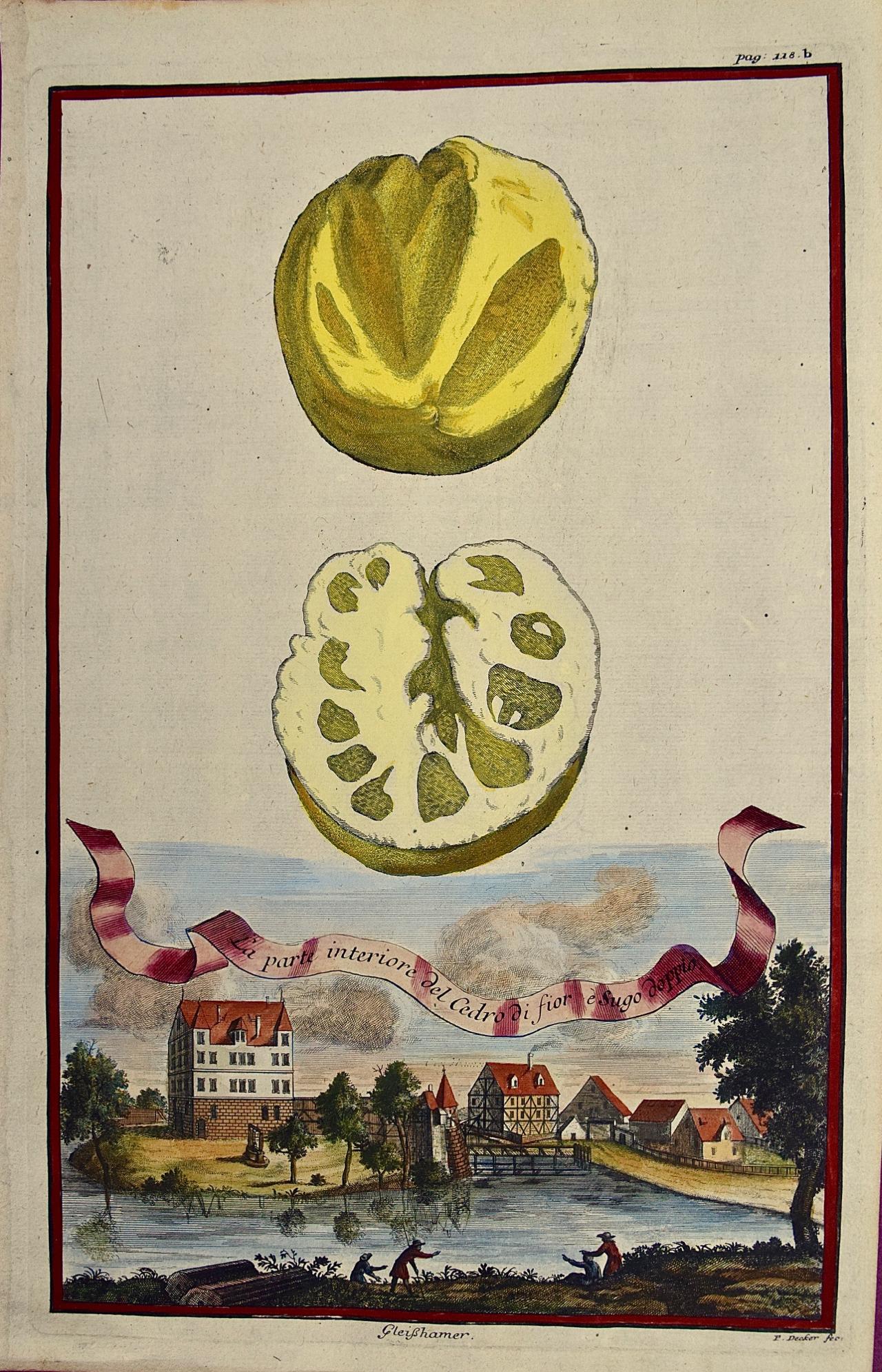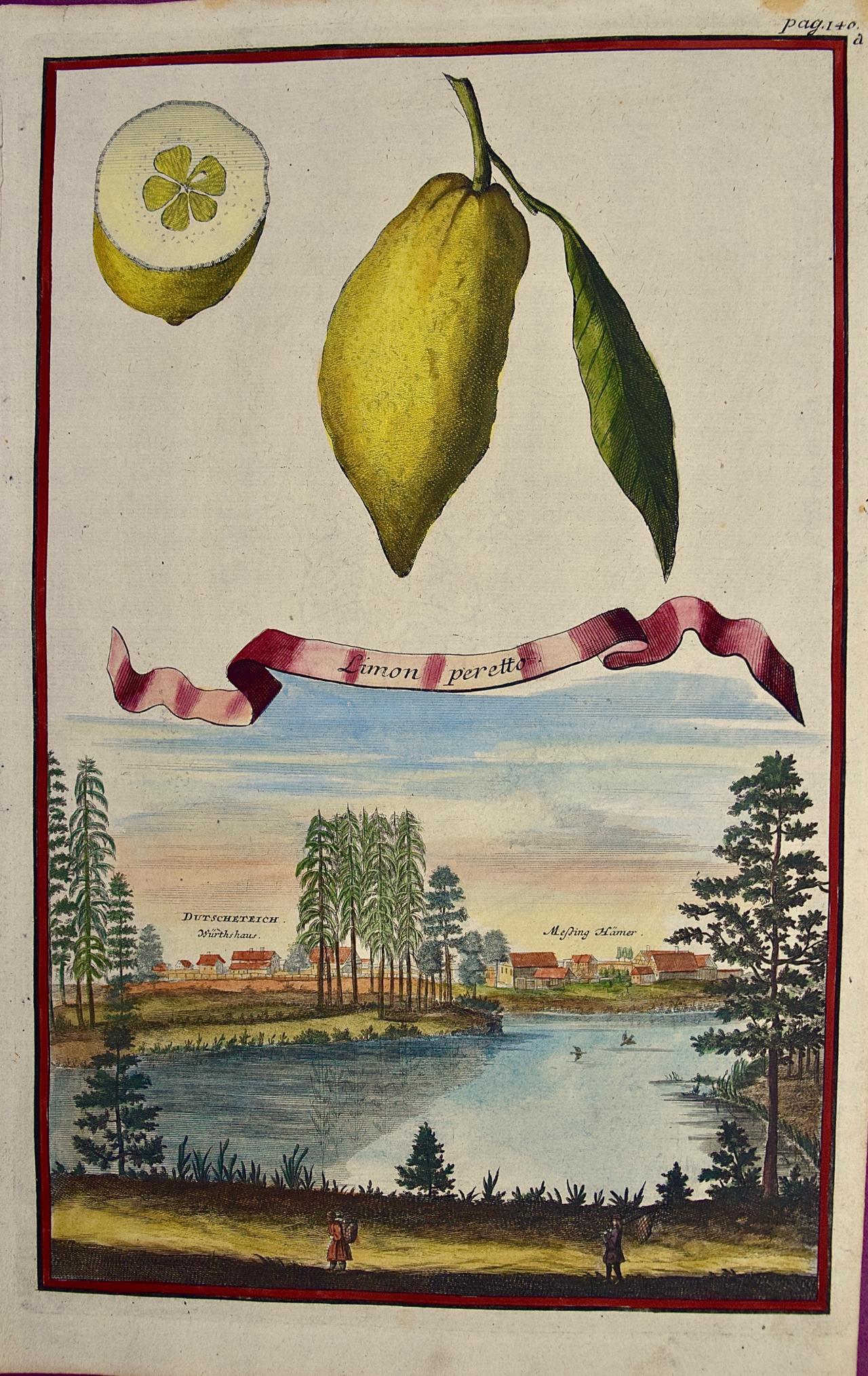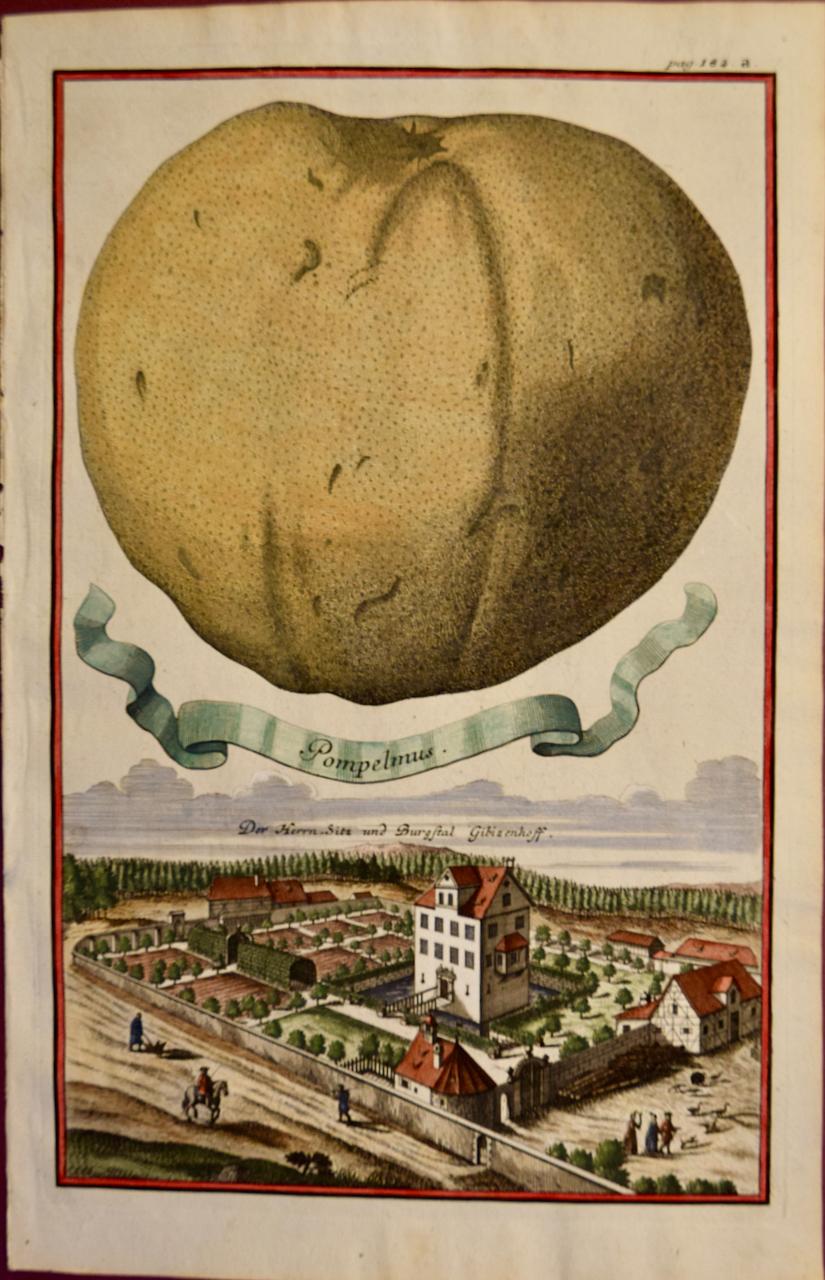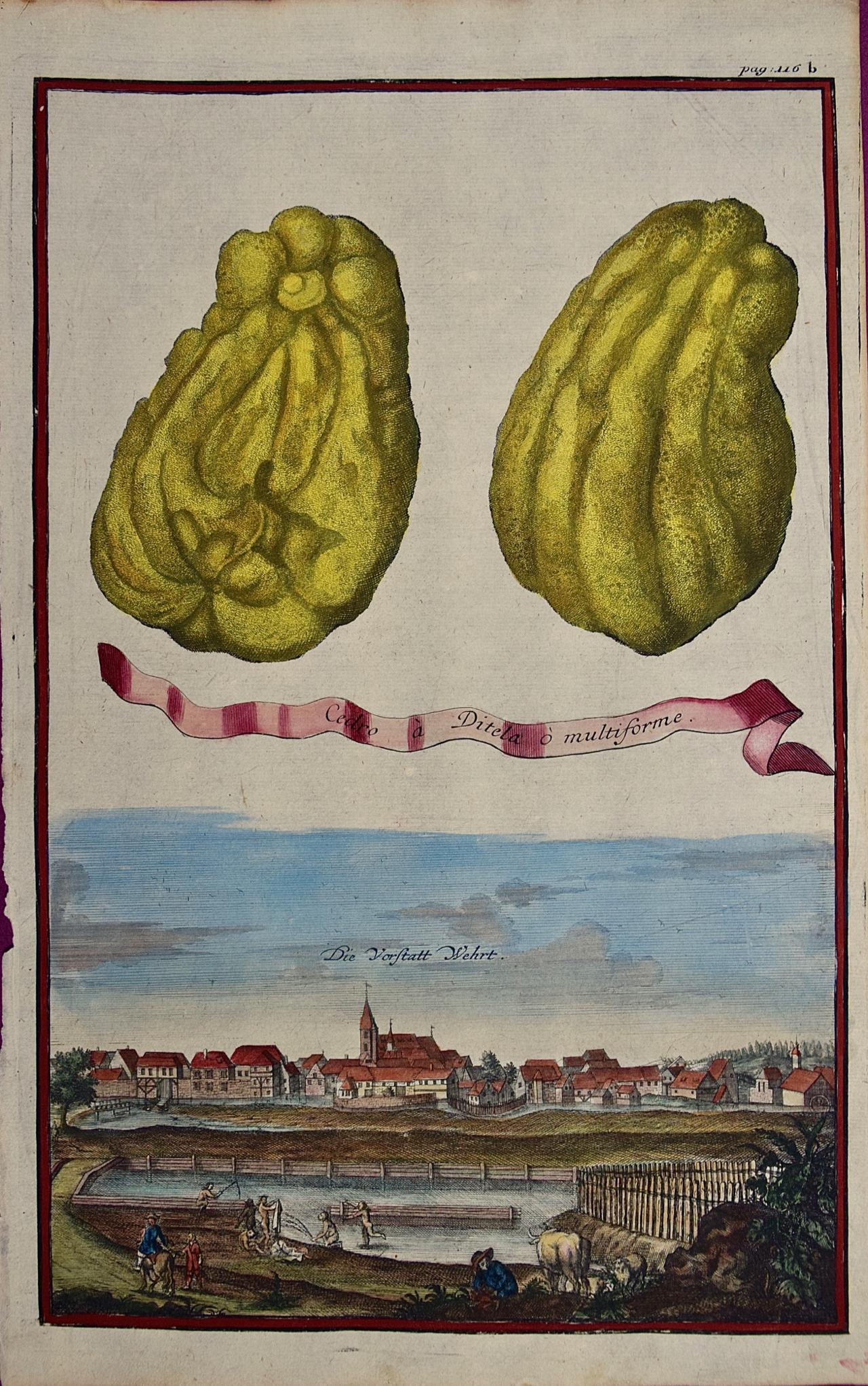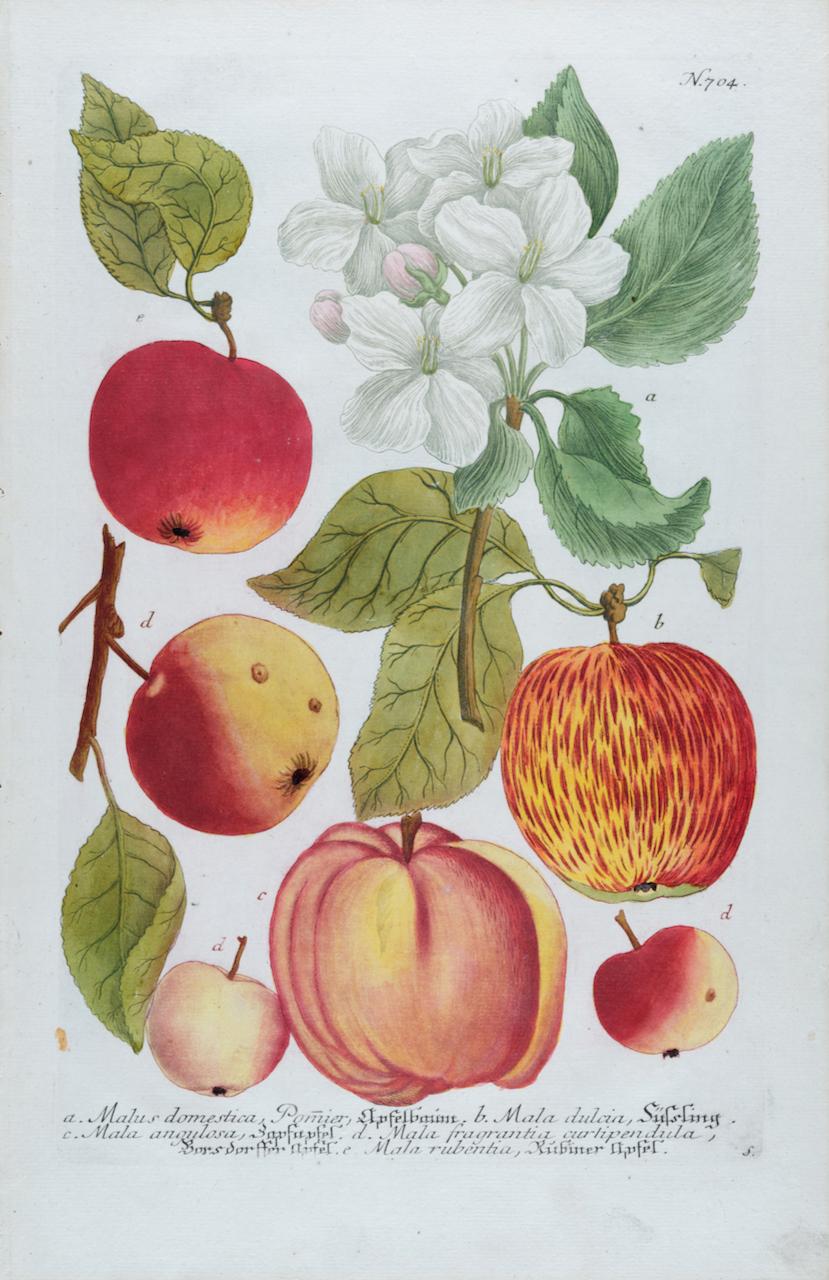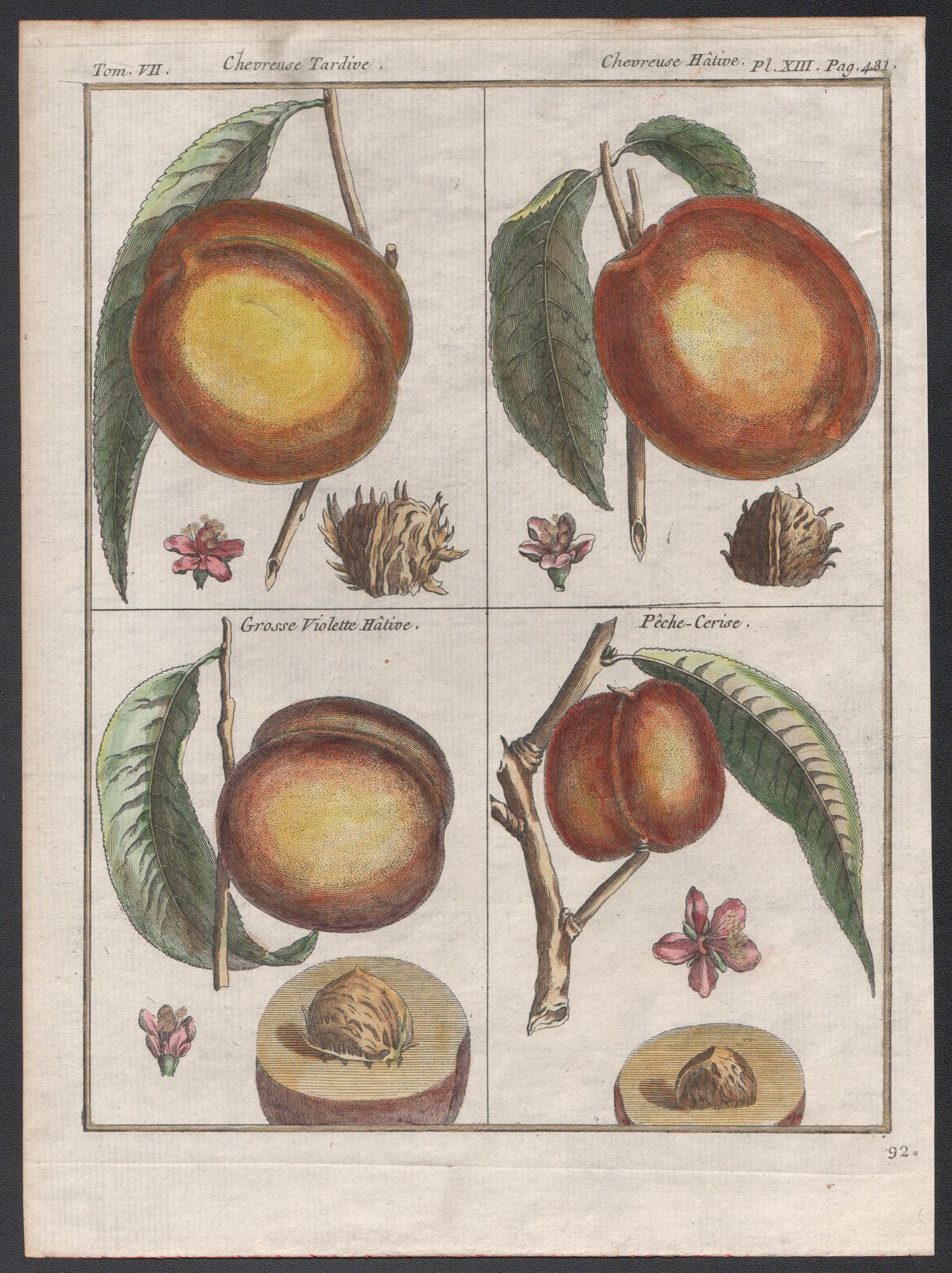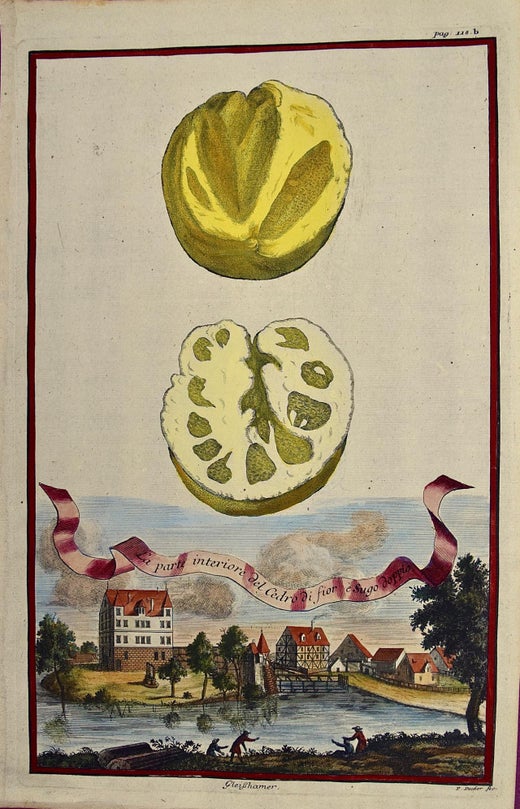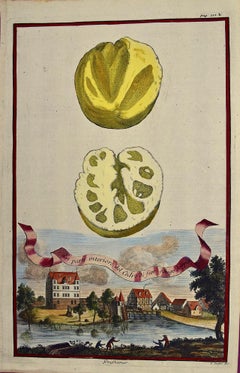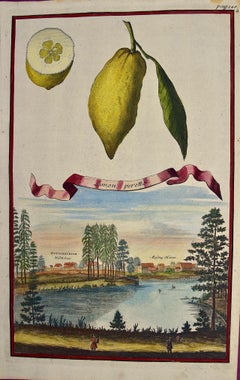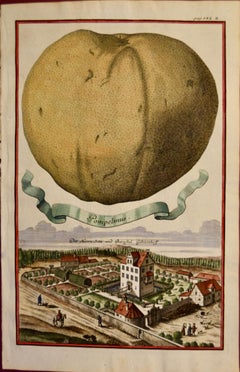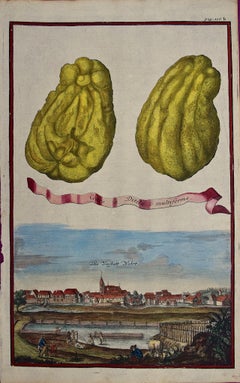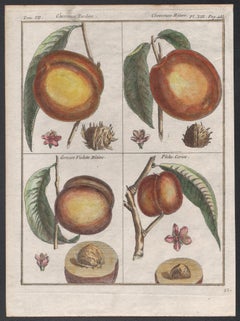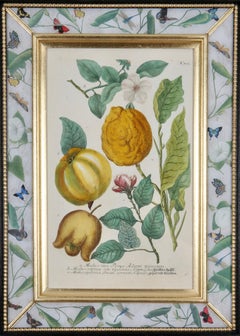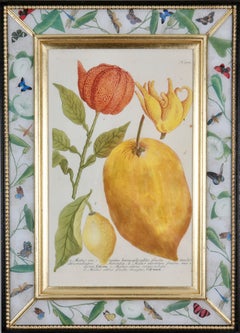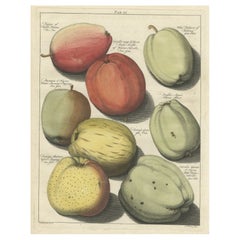Items Similar to Citrus (Cedar Flower): An Early 18th C. Volckamer Hand-colored Engraving
Want more images or videos?
Request additional images or videos from the seller
1 of 5
Johann Christoph VolkhamerCitrus (Cedar Flower): An Early 18th C. Volckamer Hand-colored Engraving1708
1708
$1,375
£1,037.67
€1,187.98
CA$1,939.21
A$2,129.01
CHF 1,110.71
MX$25,763.94
NOK 13,920.99
SEK 13,117.23
DKK 8,867.96
About the Item
This is an early 18th century hand-colored copperplate engraving of the anatomy of a Cedar Flower citrus fruit by Johann Christoph Volkhamer, entitled "Cedro di fiore e Sugo doppia (Citrus), Auf der Schutt", Pl. 118a" from his publication "Nurmbergische Hesperides", first published in Nuremberg, Germany in 1708. It depicts a Cedar Flower citrus fruit above a scene of a village. Inhabitants are seeing working, playing and riding horses in the foreground, along with two dogs.
This beautifully hand-colored Volckamer engraving is printed on hand-made 18th century laid chain-linked paper with a watermark, measuring 14" high and 8.75" wide. There is a small spot at the edge of the lower margin. It is otherwise in excellent condition.
Johann Christoph Volkhamer (1644-1720) was a German merchant, manufacturer and botanist. His illustrations of citrus fruit reflected the popularity of including new varieties of fruit available to European gardeners, as they were began to be imported from other portions of the world. These engravings are prized by collectors for their of displays of fruit flying in the sky above beautiful landscape scenes depicting towns or palaces and estates in Germany, Austria and Italy.
- Creator:Johann Christoph Volkhamer (1644 - 1720, German)
- Creation Year:1708
- Dimensions:Height: 14 in (35.56 cm)Width: 8.88 in (22.56 cm)
- Medium:
- Movement & Style:
- Period:
- Framing:Framing Options Available
- Condition:
- Gallery Location:Alamo, CA
- Reference Number:Seller: # 41201stDibs: LU1173214678332
Johann Christoph Volkhamer
Johann Christoph Volckamer (1644-1720) was a renowned botanical artist whose exquisite illustrations and detailed engravings captured the beauty and intricacy of the plant kingdom. Born in the early 17th century, Johann Volckamer hailed from the city of Nuremberg in Germany. While not much is known about his early life, his passion for botanical art soon propelled him into the realm of fame and recognition. Volckamer's artistic talent and keen eye for detail were evident in his botanical illustrations. He meticulously depicted various species of plants, flowers, and fruits, showcasing their vibrant colors, delicate structures, and natural elegance. His artworks not only possessed aesthetic appeal but also served as valuable scientific records of botanical specimens. One of Volckamer's notable achievements was his renowned work titled "Nürnbergische Hesperides" (Nuremberg Hesperides). Published in the early 18th century, this ambitious project comprised three volumes of meticulously hand-colored copperplate engravings. It showcased a remarkable collection of citrus fruits, including oranges, lemons, and other citrus varieties, as well as accompanying flowers and leaves. The vivid and lifelike depictions of these fruits made the publication highly sought after by collectors, botanists, and horticulturists of the time. Volckamer's botanical illustrations were highly regarded not only for their artistic merit but also for their scientific accuracy. His attention to detail and commitment to capturing the true essence of each plant earned him acclaim within the botanical community. His works were highly regarded by renowned botanists and scholars of the era, including his contemporaries such as Carl Linnaeus. Although much of Volckamer's life remains shrouded in mystery, his contributions to the field of botanical art continue to inspire and captivate art lovers and scientists alike. His artworks serve as a testament to his talent, passion, and dedication to the exploration and celebration of the natural world through the lens of art. Today, Volckamer's works can be found in prestigious art collections and museums, preserving his legacy as a masterful botanical artist.
About the Seller
5.0
Gold Seller
Premium sellers maintaining a 4.3+ rating and 24-hour response times
Established in 2011
1stDibs seller since 2019
291 sales on 1stDibs
Typical response time: 1 hour
- ShippingRetrieving quote...Shipping from: Alamo, CA
- Return Policy
Authenticity Guarantee
In the unlikely event there’s an issue with an item’s authenticity, contact us within 1 year for a full refund. DetailsMoney-Back Guarantee
If your item is not as described, is damaged in transit, or does not arrive, contact us within 7 days for a full refund. Details24-Hour Cancellation
You have a 24-hour grace period in which to reconsider your purchase, with no questions asked.Vetted Professional Sellers
Our world-class sellers must adhere to strict standards for service and quality, maintaining the integrity of our listings.Price-Match Guarantee
If you find that a seller listed the same item for a lower price elsewhere, we’ll match it.Trusted Global Delivery
Our best-in-class carrier network provides specialized shipping options worldwide, including custom delivery.More From This Seller
View AllLemons "La parte interiore": An Early 18th C. Volckamer Hand-colored Engraving
By Johann Christoph Volkhamer
Located in Alamo, CA
This is an early 18th century hand-colored copperplate engraving of the anatomy of lemons by Johann Christoph Volkhamer, entitled "La parte interiore del Cedro di fio e Sugo doppio" ...
Category
Early 18th Century Naturalistic Still-life Prints
Materials
Engraving
Lemons "Limon Peretto": An Early 18th Century Volckamer Hand-colored Engraving
By Johann Christoph Volkhamer
Located in Alamo, CA
This is an early 18th century hand-colored copperplate engraving of the anatomy of lemons by Johann Christoph Volkhamer, entitled "Limon Peretto" from his publication "Nurmbergische ...
Category
Early 18th Century Naturalistic Still-life Prints
Materials
Engraving
Pompelmus (Grapefruit): An Early 18th C. Hand-colored Engraving by Volckamer
By Johann Christoph Volkhamer
Located in Alamo, CA
This is an early 18th century hand-colored copperplate engraving of the anatomy of grapefruit by Johann Christoph Volkhamer, entitled "Pompelmus (Grapefruit), Der Herra Sitz und Burg...
Category
Early 18th Century Naturalistic Still-life Prints
Materials
Engraving
Lemons "Cedro Ditela Multiforme": An 18th C. Volckamer Hand-colored Engraving
By Johann Christoph Volkhamer
Located in Alamo, CA
This is an early 18th century hand-colored copperplate engraving of lemons by Johann Christoph Volkhamer entitled "Cedro a Ditela o Multiforme" from his publication "Nurmbergische He...
Category
Early 18th Century Naturalistic Still-life Prints
Materials
Engraving
Flowering Apple Plant: 18th Century Hand-colored Botanical Engraving by Weinmann
By Johann Wilhelm Weinmann
Located in Alamo, CA
This striking hand-colored botanical mezzotint and line engraving is entitled Malus domestica, Pomier, Apfelbaunt (Apple)". It is plate 704 in Johann Weinmann's monumental publicatio...
Category
Mid-18th Century Naturalistic Still-life Prints
Materials
Engraving, Mezzotint
Flowering Spurge: 18th Century Hand-colored Botanical Engraving by J. Weinmann
By Johann Wilhelm Weinmann
Located in Alamo, CA
This hand-colored botanical mezzotint and line engraving by Johann Wilhelm Weinmann (1683-1741) is entitled "A. Esula seu Tithyinalus Africanus SpinosusCera Effigie, B. Esula seu Ti...
Category
Mid-18th Century Naturalistic Still-life Prints
Materials
Engraving, Mezzotint
You May Also Like
Peach varieties, fruit engraving with later hand-colouring, circa 1770
By HL Duhamel Du Monceau
Located in Melbourne, Victoria
Peaches, Copper-line engraving with later hand-colouring, from Duhamel du Monceau’s 'Traité des Arbres Fruitiers', circa 1770.
Duhamel du Monceau (1700-1782) was one of outstanding ...
Category
18th Century Naturalistic Still-life Prints
Materials
Engraving
Johann Weinmann: c.18th Engraving of Fruit in a Decalcomania Frame.
Located in Richmond, GB
Hand-coloured mezzotint engravings from: ""Phytanthoza Iconographia"", c1739, presented in hand-made parcel-gilt, ebonised and decalcomania frames.
Johann Weinmann (1683-1741), a G...
Category
18th Century Figurative Prints
Materials
Watercolor, Mezzotint
Johann Weinmann: c.18th Engraving of Fruit in a Decalcomania Frame.
Located in Richmond, GB
Hand-coloured mezzotint engravings from: ""Phytanthoza Iconographia"", c1739, presented in hand-made parcel-gilt, ebonised and decalcomania frames.
Johann Weinmann (1683-1741), a G...
Category
18th Century Figurative Prints
Materials
Watercolor, Mezzotint
Old Original Hand-Colored Engraving of Various Apples, 1758
Located in Langweer, NL
Antique print depicting apple variaties including the Pigeon of Passe Pomme, Rode Herfst- of Winter Calville, Witte Ribbert of Ribling, Winter Parmain Pepping, Paasch Appel, Wyker Pe...
Category
Antique 18th Century Dutch Maps
Materials
Paper
$308 Sale Price
20% Off
Original Antique Hand-Colored Print of Various Apples, 1758
Located in Langweer, NL
Antique print depicting apple variaties including Witte Kruid-Appel, Rode Somer-Calville, Rode Jopen, Witte Somer-Calville, Somer Citroen Appel, Somer Kroon, Engelse Carolyn, Roos-Ap...
Category
Antique 18th Century Maps
Materials
Paper
$308 Sale Price
20% Off
Botanical Study of an Apple and Blossoms: Hand-Colored 19th-Century Engraving
Located in Langweer, NL
Title: "Botanical Study of an Apple and Blossoms: Hand-Colored 19th-Century Engraving"
Description:
This exquisite 19th-century botanical engraving showcases a beautifully detaile...
Category
Antique Early 1800s Prints
Materials
Paper
More Ways To Browse
Copperplate Engraving
18th Century Colored Engraving
Antique Riding Horse
Antique Hand Chain
Antique Citrus Prints
Month Flower Prints
Ohno Bakufu
Peter Max Marilyn
Shodo Kawarazaki
Shok 1
Walled Off Hotel Box Set
Warhol Flowers Blue
Wayne Thiebaud Lithograph
Wayne Thiebaud Pie
Wolfgang Stiller
Andy Warhol Committee 2000
Andy Warhol Flowers 1964
Andy Warhol Grapes
